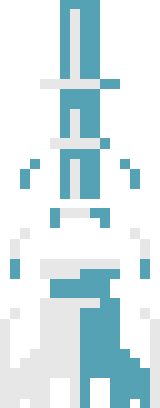Tomb of the Eaters
| Spoiler Warning: This article contains information normally only found in the course of advancing the main quest line. |
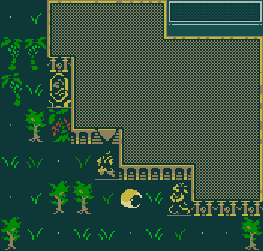
The Tomb of the Eaters is a the game's largest dungeon-like area. It plays a central role in the main quest.
The Tomb is enormous. It fills an entire parasangAn area made of 3x3 screens, which is represented as one tile on the overworld map. and extends for twelve total levels upward and downward throughout that entire area, making for a total area of more than 100 zones. The Tomb's exterior perimeter, which passes through 16 additional zones to encircle the Tomb's entire parasang, is constructed of ![]() carved stone from the sultanate of each of the five sultans that preceded Resheph. This carved stone perimeter is dotted with many recesses that are filled with golden
carved stone from the sultanate of each of the five sultans that preceded Resheph. This carved stone perimeter is dotted with many recesses that are filled with golden ![]() statues of Eaters that are in various states of weathered decay.
statues of Eaters that are in various states of weathered decay.
The Tomb is constructed around the Spindle, which extends vertically through the center of the entire Tomb. This central zone of the Tomb of the Eaters is generally inaccessible, but if the player does manage to dig or phase into this zone, it will be constructed entirely of ![]() burnished azzurum except for a circular opening in the middle of the zone. These central zones are referred to as The Spindle Channel.
burnished azzurum except for a circular opening in the middle of the zone. These central zones are referred to as The Spindle Channel.
Exterior
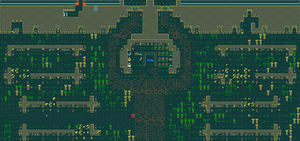
Arcade to the Twin Gates
The entrance to the Tomb is found in the Omonporch area, in a zone called Arcade to the Twin Gates, Omonporch, surface. There will be an elaborate brick walkway that leads to the Tomb from several zones to the south. The Arcade is home to ![]() Asphodel, Earl of Omonporch, a key character in the main quest sequence before the player must enter the Tomb of the Eaters.
Asphodel, Earl of Omonporch, a key character in the main quest sequence before the player must enter the Tomb of the Eaters.
This entry zone includes the twin gates that seal the Tomb, the ![]() Death Gate and the
Death Gate and the ![]() Life Gate. The player must eventually enter through the Death Gate in order to proceed in the Tomb of the Eaters questline. Attempting to enter the Death Gate before inscribing the Mark of Death will result only in seeing the message The gates are sealed for eternity. The Life Gate is not relevant to the quest and cannot be opened through normal means.
Life Gate. The player must eventually enter through the Death Gate in order to proceed in the Tomb of the Eaters questline. Attempting to enter the Death Gate before inscribing the Mark of Death will result only in seeing the message The gates are sealed for eternity. The Life Gate is not relevant to the quest and cannot be opened through normal means.
Interior - Surface Level
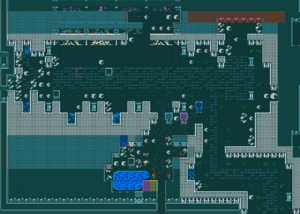
The Grand Vestibule
The entrance area within the Tomb of the Eaters lays in ruins.
This area, called the Grand Vestibule, Tomb of the Eaters, is constructed of ![]() gilded marble from the sultanate from several sultan periods, as well as
gilded marble from the sultanate from several sultan periods, as well as ![]() ebon fulcrete.
ebon fulcrete.
The Vestibule is filled with ruined sultan murals, ![]() rubble,
rubble, ![]() boulders,
boulders, ![]() bones, and other refuse. Amidst the rubble, a dark marble walkway forms a path that is also lined with a multitude of
bones, and other refuse. Amidst the rubble, a dark marble walkway forms a path that is also lined with a multitude of ![]() arc sconces and
arc sconces and ![]() holograms of Eaters. Especially in this section of the Tomb, a
holograms of Eaters. Especially in this section of the Tomb, a ![]() pickaxe or other means of overcoming solid walls may be required, as the path ahead is often blocked with rubble.
pickaxe or other means of overcoming solid walls may be required, as the path ahead is often blocked with rubble.
Although the marble walkway path is often blocked by heavy rubble and dense ![]() ebon fulcrete walls, it is possible to break (or phase) through the wall and follow the path through several screens. The zone directly to the west of the entry zone is part of the Grand Vestibule, and contains
ebon fulcrete walls, it is possible to break (or phase) through the wall and follow the path through several screens. The zone directly to the west of the entry zone is part of the Grand Vestibule, and contains ![]() elevator shafts that lead down into the Folk Catacombs. However, it is often easier to take the side tunnel rather than try to break through the walls.
elevator shafts that lead down into the Folk Catacombs. However, it is often easier to take the side tunnel rather than try to break through the walls.
The full 9-zone parasang layout of the Tomb's surface level.
| Grand Vestibule | structural rib (solid wall) |
▲ Crematory access corridor ▼ Folk Catacombs |
| Grand Vestibule | Spindle Channel | structural rib (solid wall) |
| Grand Vestibule ▼ Folk Catacombs |
Grand Vestibule Entrance |
▲ Crematory access corridor ▼ Folk Catacombs |
The nine zones are usually blocked off from each other by walls and debris. Typically, a player will descend into the Folk Catacombs and then only later ascend back upward through one of the access corridor zones. However, it is possible to bypass the Folk Catacombs entirely by digging straight into an access corridor.
Side Tunnel into the Folk Catacombs
From the first screen of the Grand Vestibule, immediately inside the Death Gate, is a dirt path leading south through two ![]() torch sconces. The path leads to the exterior wall of the Tomb, down into a
torch sconces. The path leads to the exterior wall of the Tomb, down into a ![]() deep shaft, and through a tunnel into the southwest corner of the Folk Catacombs. This tunnel runs directly underneath
deep shaft, and through a tunnel into the southwest corner of the Folk Catacombs. This tunnel runs directly underneath ![]() Ezra. It is usually covered in graffiti, possibly indicating its use by
Ezra. It is usually covered in graffiti, possibly indicating its use by ![]() graverobbers and other vandals.
graverobbers and other vandals.
The side tunnel is usually the path of least resistance. It is one of the easiest and most accessible entry points to the Tomb. It leads to an area on the western edge of the Catacombs, close to the mopango enclave and its related questlines.
Folk Catacombs
The Folk Catacombs are the lowest layer of the Tomb. Each zone is divided into areas by large chunks of ![]() compacted bone, which can be tunneled through easily with a
compacted bone, which can be tunneled through easily with a ![]() pickaxe. Locations which are safe from the Bell of Rest are marked with a diamond-shaped tile pattern and grant the tomb-tethered effect. The southeast and northeast zones contain stairs leading up to the access corridor on the next level. Most other zones contain a
pickaxe. Locations which are safe from the Bell of Rest are marked with a diamond-shaped tile pattern and grant the tomb-tethered effect. The southeast and northeast zones contain stairs leading up to the access corridor on the next level. Most other zones contain a ![]() stairwell teleporter, which will teleport the player to one of these sets of stairs.
stairwell teleporter, which will teleport the player to one of these sets of stairs.
The Folk Catacombs are populated by ![]() conservators,
conservators, ![]() graverobbers,
graverobbers, ![]() mopango tombdwellers and
mopango tombdwellers and ![]() charioteers,
charioteers, ![]() gelatinous cupolas, and
gelatinous cupolas, and ![]() bone worms (which can fill areas with even more compacted bone). They may also contain death pilgrims of various Sultan cults, which are drawn from the faction pool of their respective cult.
bone worms (which can fill areas with even more compacted bone). They may also contain death pilgrims of various Sultan cults, which are drawn from the faction pool of their respective cult. ![]() k-Goninon, a legendary ooze connected to the Fraying Favorites quest, always spawns in a random zone in the Folk Catacombs.
k-Goninon, a legendary ooze connected to the Fraying Favorites quest, always spawns in a random zone in the Folk Catacombs.
Mopango Enclave
The northwest corner of the Tomb contains a mopango enclave, home to ![]() Agyra,
Agyra, ![]() Vivira, and
Vivira, and ![]() Lebah as well as other mopango. Its
Lebah as well as other mopango. Its ![]() bone oven contains Bone Babka, a meal which grants
bone oven contains Bone Babka, a meal which grants ![]() Burrowing Claws, as well as an AV boost upon identifying an artifact. The enclave is connected to the quests The Buried Watchers and Fraying Favorites.
Burrowing Claws, as well as an AV boost upon identifying an artifact. The enclave is connected to the quests The Buried Watchers and Fraying Favorites.
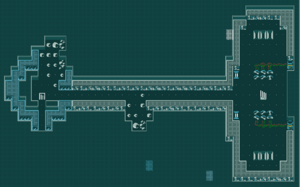
Access Corridor
There are two access corridors on the surface level that act as connecting zones between the Folk Catacombs below and the Crematory above. These areas contain several ![]() industrial fans that can potentially blow the player or other creatures into shafts that lead back downward into the Folk Catacombs. The Bell of Rest does not apply in the access corridors.
industrial fans that can potentially blow the player or other creatures into shafts that lead back downward into the Folk Catacombs. The Bell of Rest does not apply in the access corridors.
It is possible to tunnel directly to the southern access corridor through the outer wall of the spindle from the north-eastern zone of ![]() Omonporch, bypassing the folk catacombs entirely. The shortest point through the walls is straight north, seven tiles from the eastern edge of the zone.
Omonporch, bypassing the folk catacombs entirely. The shortest point through the walls is straight north, seven tiles from the eastern edge of the zone.
Interior - Crematory Level
The crematory level is the level 1 strata above ground, reached from the access corridor.
The crematory proper, in the eastern two-thirds of the parasang, is built of ![]() machine walls which leave behind puddles of
machine walls which leave behind puddles of ![]() lava when broken. It features a large number of hazards along -conveyor belts which move to the west. Hazards include
lava when broken. It features a large number of hazards along -conveyor belts which move to the west. Hazards include ![]() machine press,
machine press, ![]() rotating machine arms which can drop the player into deep shafts down to the Folk Catacombs, and
rotating machine arms which can drop the player into deep shafts down to the Folk Catacombs, and ![]() steaming vents which emit jets of fire at regular intervals. Towards the end of each zone, the northern and southern edges are lined with rows of
steaming vents which emit jets of fire at regular intervals. Towards the end of each zone, the northern and southern edges are lined with rows of ![]() industrial fans which can blow the player into shafts. Behind each row of fans are two
industrial fans which can blow the player into shafts. Behind each row of fans are two ![]() fusion power stations and a
fusion power stations and a ![]() scrapable deposit box containing an item from the Artifact 6R table.
The
scrapable deposit box containing an item from the Artifact 6R table.
The ![]() fusion power stations can be deactivated with
fusion power stations can be deactivated with ![]() maintenance security cards or above, which disables the fans.
maintenance security cards or above, which disables the fans.
Following the conveyer belts west leads to the Columbarium: Landlords and Changers, which takes up the western third of the parasang and is full of ![]() funerary urns and
funerary urns and ![]() statues of Eater. The center of the Columbarium contains stairs up to the next level. Following the conveyer belts backwards to their source leads to the Crematory Machine Room in the center easternmost zone, which contains two guaranteed
statues of Eater. The center of the Columbarium contains stairs up to the next level. Following the conveyer belts backwards to their source leads to the Crematory Machine Room in the center easternmost zone, which contains two guaranteed ![]() cybernetics credit wedge 3¢.
cybernetics credit wedge 3¢.
Within the crematory proper, the Bell of Rest always returns the player to a small area on the eastern edge of the crematory, forcing them to traverse the entire crematory again to reach the Columbarium. The Bell does not apply within the Columbarium.
The crematory proper is populated by ![]() conservators,
conservators, ![]() graverobbers,
graverobbers, ![]() gelatinous cupolas, and death pilgrims, similar to the Folk Catacombs. The crematory also contains
gelatinous cupolas, and death pilgrims, similar to the Folk Catacombs. The crematory also contains ![]() strip flies, which can steal items. The Columbarium is populated only by docile
strip flies, which can steal items. The Columbarium is populated only by docile ![]() urn dusters.
urn dusters.
Crypts
The Crypts are the levels 2 and 3 strata above ground. They are divided into the Lower Crypts: Warriors and Tutors, at 2 strata high, and the Upper Crypts: Priests and Royal Families, at 3 strata high.
The most notable features of these layers are their namesake crypts. These are structures of ![]() ornately carved marble which usually contain the
ornately carved marble which usually contain the ![]() sarcophagus and
sarcophagus and ![]() reliquaries of the deceased (though sometimes they instead contain mopango and scrap). The interiors of these crypts grant the tomb-tethered effect, making the player safe from the Bell of Rest.
reliquaries of the deceased (though sometimes they instead contain mopango and scrap). The interiors of these crypts grant the tomb-tethered effect, making the player safe from the Bell of Rest.
The contents of ![]() reliquaries depend on the caste of the family buried within, which can be determined by reading the descriptions of the walls and the
reliquaries depend on the caste of the family buried within, which can be determined by reading the descriptions of the walls and the ![]() door plaque. Each
door plaque. Each ![]() reliquary pulls either once or twice from the following set of options:[1][2][3]
reliquary pulls either once or twice from the following set of options:[1][2][3]
| Level | Caste | Reliquary contents |
|---|---|---|
| Lower Crypts | Warrior | melee weapon (40% chance), armor (30% chance), or missile weapon (30% chance), at tier 6 (75% chance) or 7 (25% chance) |
| Tutor | ||
| Upper Crypts | Priest | Tier 4-7 artifact (75%) or |
| Royal | Tier 4-7 artifact (75%) or |
Most crypts are protected by ![]() crypt sitters, which awaken when the reliquary is opened, regardless of whether an item was taken from it. They can also be awakened by
crypt sitters, which awaken when the reliquary is opened, regardless of whether an item was taken from it. They can also be awakened by ![]() crypt ferrets stealing items.
crypt ferrets stealing items.
In addition to the crypts themselves, the Lower Crypts are filled with swaths of ![]() stillvine, with a scattering of holigraphic trees. The Upper Crypts instead contain more controlled gardens of various plants, including
stillvine, with a scattering of holigraphic trees. The Upper Crypts instead contain more controlled gardens of various plants, including ![]() stillvines,
stillvines, ![]() brightshrooms, holographic trees,
brightshrooms, holographic trees, ![]() lagroots,
lagroots, ![]() sunflowers,
sunflowers, ![]() aloe portas,
aloe portas, ![]() vantabuds, and
vantabuds, and ![]() fractus. Both Crypt layers have substantial patches of
fractus. Both Crypt layers have substantial patches of ![]() grave moss.[1][2][3]
grave moss.[1][2][3]
The Crypts are heavily populated by ![]() crypt ferrets. They have extremely high DV and can latch onto enemies, preventing them from moving. They are members of the hidden Beasts faction, whose reputation cannot be normally raised, and will thus almost always be hostile to the player, as well as most of the other inhabitants of the Crypts. Their bite can cause bleeding, which can awaken
crypt ferrets. They have extremely high DV and can latch onto enemies, preventing them from moving. They are members of the hidden Beasts faction, whose reputation cannot be normally raised, and will thus almost always be hostile to the player, as well as most of the other inhabitants of the Crypts. Their bite can cause bleeding, which can awaken ![]() grave moss into
grave moss into ![]() gorged growth. However, they do not tend to chase targets outside of melee range. They can steal items from
gorged growth. However, they do not tend to chase targets outside of melee range. They can steal items from ![]() reliquaries and teleport away.
reliquaries and teleport away.
The Crypts are also inhabited by mopango, death pilgrims, ![]() conservators,
conservators, ![]() graverobbers,
graverobbers, ![]() gelatinous cupolas, and
gelatinous cupolas, and ![]() ghost perches.
ghost perches.
At least one of the zones in each level of the Crypts contains stairs to the next level up. Other zones may contain ![]() stairwell teleporters which teleport the player to these stairs.
stairwell teleporters which teleport the player to these stairs.
Sultan Tombs
The layers above the Upper Crypts contain the tombs of the historic sultans. They are affected by a powerful ambient "astral friction", which applies normality with strength 40 to all creatures within the zone, and has a 90% chance to deflect esper attacks:
Some dimensional interlopers attempt to enter this region of spacetime, but the ambient normality field keeps them at bay. |
Each level contains a U-shaped hallway of ![]() gilded marble from the era of the sultan to whom the tomb belongs, lined with
gilded marble from the era of the sultan to whom the tomb belongs, lined with ![]() holograms of Eater, with a main room in the center northern zone of the parasang. This main room contains an
holograms of Eater, with a main room in the center northern zone of the parasang. This main room contains an ![]() imperial sarcophagus, a
imperial sarcophagus, a ![]() sultan reliquary, and several sultan murals. The murals display alternate descriptions of events from the history of the sultan in question.
sultan reliquary, and several sultan murals. The murals display alternate descriptions of events from the history of the sultan in question.
Each ![]() reliquary contains the respective sultan's mask, as well as any relics which the sultan obtained and did not lose in their lifetime. They are guarded by cherubim from factions associated with the sultan, which have dynamic abilities depending on the sultan's theme. There are four cherubim for the first sultan, three for the second, two for the third, three mechanical cherubim for the fourth, and two mechanical cherubim for the fifth. Items cannot be taken from the reliquaries while the cherubim are present, though the reliquaries can be freely opened to view the items inside. Taking an item from a reliquary will cause "robber chimes" to sound, making all other reliquaries disappear.
reliquary contains the respective sultan's mask, as well as any relics which the sultan obtained and did not lose in their lifetime. They are guarded by cherubim from factions associated with the sultan, which have dynamic abilities depending on the sultan's theme. There are four cherubim for the first sultan, three for the second, two for the third, three mechanical cherubim for the fourth, and two mechanical cherubim for the fifth. Items cannot be taken from the reliquaries while the cherubim are present, though the reliquaries can be freely opened to view the items inside. Taking an item from a reliquary will cause "robber chimes" to sound, making all other reliquaries disappear.
Unfinished Tomb
The top tomb, 10 strata high, would have been the tomb of Resheph, but is unfinished. It contains no cherubim and thus the ![]() Null Face can be freely taken from the reliquary, although this locks out all the other Sultan reliquaries.
Null Face can be freely taken from the reliquary, although this locks out all the other Sultan reliquaries.
By talking to ![]() Herododicus, the player (with a tattoo of the Mark of Death) can demand to be entombed. Herododicus will engrave murals depicting the player's achievements. After the murals are complete, the player can enter the
Herododicus, the player (with a tattoo of the Mark of Death) can demand to be entombed. Herododicus will engrave murals depicting the player's achievements. After the murals are complete, the player can enter the ![]() imperial sarcophagus to travel to Brightsheol.
imperial sarcophagus to travel to Brightsheol.
Cross-Zone
The Bell of Rest
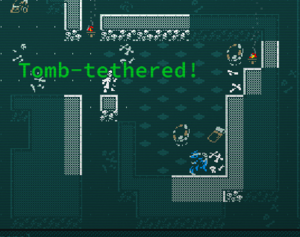
A player who has the Mark of Death on their body is affected by the Bell of Rest. The Bell of Rest rings every 300 turns, with a countdown that appears in purple text in the message log. At the end of the countdown, the player is teleported to a random Place of Rest. The places of rest are spaces marked with a checkerboard-like tile. If the player is in a place of rest, they receive an effect called Tomb-tethered. If the player is Tomb-tethered when the Bell of Rest rings, they will not be teleported.
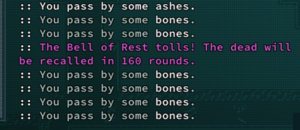
In the Folk Catacombs, the Places of Rest are scattered around randomly. However, as the player progresses to less damaged areas of the Tomb, Places of Rest are more reliably available in the intact crypts. There is usually at least one Place of Rest per zone.
If the zone is re-entered after completing the Tomb's quest, the teleportation effect of the Bell of Rest is disabled, and the Tomb can be freely explored. This is true even if the player has tattooed the Mark of Death on their body again. However, the Tomb-tethered alert will still appear whenever they move onto a checkerboard tile region.
Children of the Tomb
The Children of the Tomb are four biomechanical creatures which inhabit the Tomb, each watched over by a mopango. They are ![]() Kah (watched by
Kah (watched by ![]() Gyamyo),
Gyamyo), ![]() Dagasha (watched by
Dagasha (watched by ![]() Yona),
Yona), ![]() Nacham (watched by
Nacham (watched by ![]() Doyoba), and
Doyoba), and ![]() Va'am (watched by
Va'am (watched by ![]() Dadogom). One Child of the Tomb and its associated watcher spawns in each of the four zones (Folk Catacombs, Columbarium, Lower Crypts, and Upper Crypts). The order is random.
Dadogom). One Child of the Tomb and its associated watcher spawns in each of the four zones (Folk Catacombs, Columbarium, Lower Crypts, and Upper Crypts). The order is random.
